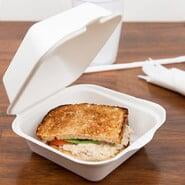A PREVIOUSLY EXCITING DEVELOPMENT THAT FALLS SHORT IN COMPOST PERFORMANCE & PRACTICAL USE
Unfortunately, bioplastics were first a disappointment to business owners when they began melting upon contact with hot foods and beverages. The second disappointment came when commercial composters and industrial composting facilities found that many bioplastics didn’t biodegrade as advertised. Even products marked “fully compostable in industrial facilities” took years to break down in 200℉ + industrial compost windrows. They were also deemed incompatible with many anaerobic digestion facilities. So now we have plenty of people asking, “What do I do with this ‘green cup’? Is it really better for the environment? And should I even really be composting it?”
Bioplastics market well, but as we’ve seen, they often do not compost well. The truth is: a cup made out of highly processed corn and biopolymers is not invariably compostable. How the cup, lid or box is produced, in addition to what it’s made out of, determines how well it will break down in a composting environment. We either need higher tech bioplastics that can withstand normal consumer use while also biodegrading at a rate more comparable to raw food waste, or more likely in the short term, we need to be using different products altogether.
You might think “What’s the matter with a little bioplastic mixed in with compost? So what if it takes a longer time to break down. It eventually will, right?” To shed some light on this, let’s look at the composting lifecycle. CERO Cooperative delivers food waste to local compost farms where it is carefully managed, turned, and composted in open-air windrows. Once finished, the compost is used by local farmers and landscaping companies to grow next year’s food and gardens. The point of composting is to harness the carbon, nitrogen, and other valuable nutrients stored in our food waste, and recycle it into new vegetation rather than have it rot in landfills and generate methane, a potent greenhouse gas. Bioplastics don’t contribute to this goal, as they don’t have any significant nutritional value. Composting them simply dilutes the nutrients from the true food waste, or worse, leads to an ever growing heap of stubborn bioplastics that will not break down and can’t be returned to the earth as promised.
So what’s the solution? Ideally, it is to use reusable, washable cutlery and dishware whenever possible. When this isn’t possible and single-use items must be enlisted, those ‘green’ bioplastics might seem cool, but there are products out there that stand up better to consumer use, and also compost more reliably!
One such product is bagasse. Made from the fibrous material that remains after sugarcane stalks are crushed to extract their juice, it holds up well to higher heats, while breaking down in as little as 3 months at industrial composting facilities. There are many food service products made from bagasse, such as these to-go clamshells.

We support every effort to reduce the volume of material sent to landfills, but bioplastics in their current form are not the answer to this dilemma. It breaks our zero-waste hearts to see folks buy these products with the best of intentions, only to see their efforts and investment foiled by inferior product performance.
However, there is hope! CERO has worked with schools and restaurants (shout out to The Shady Hill School and Mei Mei, blog post coming later) to successfully make the transition to more affordable, reliable, and truly compostable bagasse and paper products. Better yet, some places have even increased usage of reusable cutlery and dishware (shout out to Equal Exchange Café!).
If food waste loads contain concentrated amounts of bioplastics, much of it will inevitably be screened out when these products fail to break down in a timely fashion. This does nobody any good: not the consumer, the buyer, nor the composter. Instead, let’s push to prioritize reusables whenever possible! And when it isn’t possible, using products made of reliably compostable paper and bagasse are a much better investment if you really care about going green!

